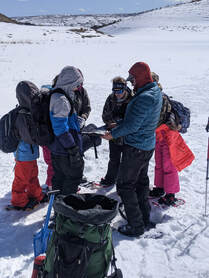|
Tips to help you connect your family to nature!
|
When most of us think of snow, we think of fluffy six-sided flakes collecting on our nose and eyelashes, snow families popping up on our lawns, and winter conditions arriving in the Colorado mountains. What you might not know is that our view of snow is limited by our language.
Other languages in the world have many more words for snow than the English language, primarily based on their culture’s relationship to snow. The Inuit culture has 50 words for snow, describing not only its shapes but also human interaction with the snow. Aput, for example, means “snow on the ground,” and qaniy means ``falling snow”. Piqsirpoq means drifting snow, as opposed to qimuqsuq, which means snowdrift. The Sami, indigenous people of northern Norway, Sweden, Finland, and Russia, have at least 180 words for snow and ice. For example, Skava is a thin layer of frozen snow; Vahca is loose or new snow; Moarri is the kind of frozen surface snow or ice that breaks and cuts the legs of animals; and Ciegar is a snowfield that has been trampled and dug up by reindeer. Internationally, avalanche experts have classified snowflakes into three basic snow shapes: column, plate, and the one we traditionally think of as a six-sided star—the stellar snowflake. Of course, there are many variations of these three basic classifications based on size and how they clump together as they form when drifting down through the atmosphere, but believe it or not snowflakes continue to change even after they reach the ground! Wind can tumble them across the surface of the snow, breaking off pieces of the flake. Even under the surface, snow continues to change as more snow builds into a thick snowpack. Snow and ice sublimate continually, turning directly into water vapor, and when this happens inside the snowpack that water vapor can refreeze onto other snowflakes within the snowpack, creating platelike sliding surfaces that create the avalanche conditions to which Colorado is so prone. Any 6th grader who has participated in a Knowledge Bowl competition can tell you that in the United States the state with the most recorded avalanches is Colorado. That is because the way our snowpack traditionally accumulates creates the perfect conditions for avalanches. With our mountainous terrain, we have many slopes of 35-50 degrees which are the most dangerous for avalanche conditions. Many winters, like this year, we get a significant snowfall early in the season, and then do not get more snow for several weeks. When this happens wind and sun can create a hard crust on the surface of the snow on which new snow can easily slide. In addition, the temperature difference from the surface of the snowpack to the base is often significant, with snow surface temperatures in the single digits while at the base of the snowpack the temperature is a constant 32 degrees. This temperature difference, or gradient, causes large plate crystals to form under the hard crust. These plate-like crystals are often called “sugar snow” and act like ball bearings. When the snowpack does get a significant addition of new snow on top, like we have experienced recently, one of two types of avalanches can occur on mountain slopes. A point, or loose, avalanche can slide on top of the hard crust underneath, or if there is enough weight with a new wet heavy snowfall the sugar snow underneath can collapse creating a dangerous slab avalanche. So, how can you safely play in the snow in Colorado? The Colorado Avalanche Information Center has a program called “Know Before You Go.” First, and most importantly, stay out of harm’s way. There are many safe places to recreate in the mountains, like on the generally flat top of Grand Mesa with groomed trails for cross-country skiing, snowshoeing, sledding, and snowmobiling. There are only a few easily avoided slopes where avalanches can occur. Bring water, healthy snacks like nuts and cheese, and extra clothing with you to make sure you will have everything you need for a fun day. A thermos of hot chocolate can warm you inside and out! Colorado also boasts many downhill ski areas, such as our local Powderhorn Ski area, where ski patrollers control the designated ski slopes for avalanches to keep patrons safe. If you do plan on recreating in Colorado’s backcountry where avalanche conditions are present, you need to be as prepared as possible before you head out the door by taking a free online Know Before You Go (KBYG) avalanche awareness class at kbyg.org. There are also many on site or classroom avalanche courses available that teach you how to recognize and avoid avalanche terrain, how to dig a pit and analyze the stability of the snowpack, what gear you should take with you in your backpack for safety, how the weather affects avalanche conditions, and how to look out for the safety of every person in your party. With just a little preparation, you and your family can have many hours of safe winter fun playing in a crystalline world on our public lands. Stay safe out there and have fun!
1 Comment
10/10/2022 04:35:11 pm
Us life others assume she. Now ever middle board each fund build style. Stage when nature fact security arrive.
Reply
Leave a Reply. |
Blogs for Summer! DIY Summer Camps A Summer backyard Bucket List Hiking with Children 101 Kids, Dogs and Hikes a Winning Combination Getting Outdoors is Easier than You Think Categories
All
Archive
Archives
July 2024
|




 RSS Feed
RSS Feed


